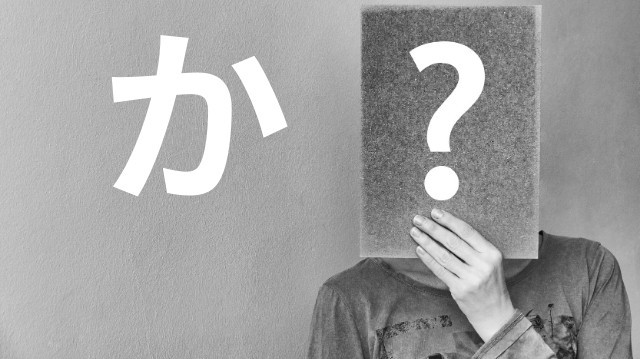Today we are going to talk about the ka particle in Japanese. This is a very common one that most people learn early on in their studies, but there is a lot of information contained in this one word.
In the first section we will cover the most common use of か, but then we will talk about a close, yet different meaning that gets used pretty often.
After this, there is a less common usage that I wanted to go over so that you can recognize it when you see it.
Used For Real Questions
The most common way that か is used in Japanese is as a spoken question mark (?) which then turns the entire sentence into a question.
This is also done by using a rising intonation on the final syllable, very similar to what we do in English.
One thing that you should know is that since the か at the end of a sentence turns it into a question, the Japanese people often feel that they do not need to add on ? to the end, and instead they opt for their version of a period (。).
- お元気ですか。
- ogenki desu ka?
- Are you well?
That being said, a lot of manga artists like the artistic look and feel that a question mark adds, so they will include the question mark in addition to using か.
So, this concept is pretty simple, right? I don’t think that I really need to go into too much more depth on how か is typically used.
But, wait!
There is one special thing that is that very few people talk about and that is how this question particle can help you understand the context of the situation.
Japanese is a very context heavy language which means that the information that is not said is often times more important than the stuff that is said when it comes to understanding the message that is being conveyed.
How this comes into play with か is that when a sentence doesn’t explicitly tell you who is speaking, sometimes this particle can give you a hint.
Compare 元気ですか which means “Are (you) well?” with 元気です which means “(I) am well.”
Neither of these sentences straight out tells you if it should be “I” or “you” in the interpretation, but we can figure it out from that one particle.
We only ask questions to the person we are talking to when we don’t know the answer. Hence か letting us know that “you” is the correct interpretation.
Likewise, we can only say for certain how we are faring in our own lives as it’s not right for us to speak for someone else. That means when we aren’t asking a question, but making a statement, it has to be “I” as the right translation.
This is a little trick that can help out a lot with deciphering the ambiguities of the language when you’re first starting out.
Used For Not-Real Questions
When I say “not-real question” I am talking about a couple of different things, but the basic idea is that it sounds like a question, but isn’t really one.
For example, rhetorical questions are phrased like a real question, but they aren’t truly meant to be answered. They are generally used to convey some other sort of message, such as contempt, doubt, or something else.
- こんなにきれいな所が、ほかにあるだろうか。
- konnani kireina tokoro ga, hoka ni aru darou ka?
- Is there another place as lovely as this?
Let’s think about the above example. If you’re in an incredibly beautiful part of nature and you feel a deep connection, you might say something like the above phrase to the person who is there with you.
But you’re not actually asking them if there is another place as beautiful, you’re just expressing that you feel like the place you are in is the most amazing on earth.
Another example of a “not-real question” is when a person is expressing disbelief.
Perhaps this appears more in anime than real life, but let’s say that there’s a 100 story building and you want to get to the top of it to see the view, but you can’t get in because it’s currently closed.
You tell your friend that this bums you out, but then they give you a suggestion: “You can just climb up the building to get to the top.” To which you reply:
- できるか!
- dekiru ka!
- Like hell I can!
At first glance you might think that this question means “can I?” since the word できる means “can do” and then we add on the question marker.
But it’s not a serious question, and if you heard the person say this their tone of voice would give it away. Here, the exclamation mark tries to let the reader know its true meaning.
Can Be Used For “Or”

Alright, let’s take a break from questions and talk about a completely different usages of か in sentences. This time instead of it appearing at the end of a sentence, it will actually appear somewhere in the middle.
When this happens, it is usually translated as “or” in English, and can appear is a couple of scenarios.
The first one is when you have a choice of a couple of items.
- コーヒーかお茶
- kōhī ka ocha
- coffee or tea
But it’s not just limited to nouns, it can also be used with verbs. Often times you will see multiple ka’s used to say things like “should I do this, or should I not do this?” and the like in Japanese.
- 行くか行かないか
- iku ka ikanai ka
- to go, or not to go
I think the biggest giveaway for this usage is that it typically appears in the middle of a sentence, and sometimes is repeated after both the positive and negative version of the same verb.
I don’t see it all that much, but keep it in mind as it will sometimes appear.
Used With Question Words
Now we’re back to the questions. But this time it is a little different because I’m are going to be talking about questions words. These are the classic “who, what, where, when, and why.”
These words, like いつ (itsu) for “when” can have か added on to the end of them and it generally changes their meaning to something that has to do with the English words “some” or “any” like in the following examples.
- いつか = sometime
- 誰か = someone
- 何か = something
- どこか = somewhere
- なぜか = somehow
This is kind of similar to how adding も (mo) on to these types of words also changes them in a particular way, but I digress.
There are a few particles that can add on to these words in this way, but I really just wanted to give them a once over with the か versions since it fits in so nicely with today’s topic.
Any Questions?
I hope that you learned a lot from this post, and I also hope that the explanations and examples were clear enough to make it easy to understand.
If not, the please let me know by leaving a question down below. I always try to do my best, but I’m sure that there are times when I could do a better job.
At any rate, thanks for reading and I will catch you next time!
Further Resources for Learning Japanese:
#3 Get My eBook (Secrets to Learning Japanese) for Free

またね!
